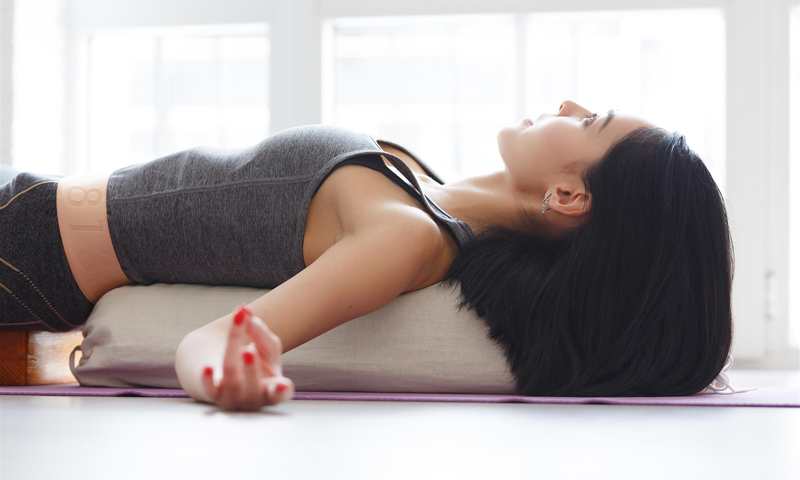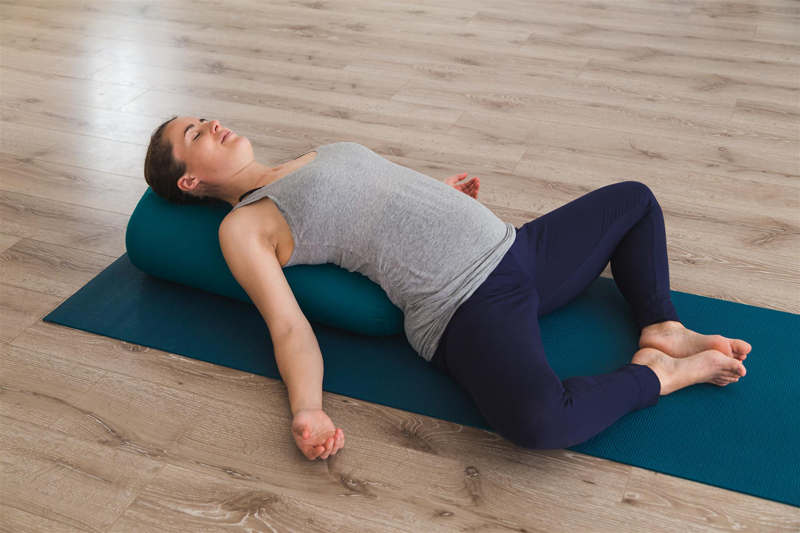
What is Chair Yoga?
July 19, 2018
Benefits of Using a Yoga Ball Chair
August 2, 2018Benefits of using Yoga Bolsters

Many people believe that yoga is the greatest physical exercise in the world. Unlike other forms of exercise, yoga heals the body and mind simultaneously and creates harmony between both. Additionally, the exercise can accommodate yogis of all sorts – even those with physical limitations. If you find regular asanas tricky, you can use various different props to make them easier to achieve. One of the most popular props is a yoga bolster. Typically shaped like a cushion, a yoga bolster can be used to support the body throughout your practice. For best results, remember to use the prop on top of a large yoga mat. In this article, we explore the benefits of using yoga bolsters.
Benefits of Using a Bolster
Supports to the Body
A bolster supports the body when you are performing complex poses. The prop is particularly helpful for beginners and those with limited mobility as it provides additional support throughout each posture. It’s not uncommon for complicated poses to be tricky, and sometimes even painful, to achieve. A yoga bolster helps to ease the pain by providing the body with correct alignment throughout. The prop can be used in a variety of different positions with some of the most popular being below the knees, hips, neck, and legs.
Improves Your Posture
In some asanas, it can be hard to keep a good posture – especially if you’re practicing independently. When attending a yoga class, you have a qualified instructor is to ensure your posture is proper. If you choose to practice at home, however, you have to do this yourself. This is where a bolster can come in handy. When placed under the hips, a bolster helps to keep your spine correctly aligned. Not only will this help to prevent injury and excess tension from occurring, it will also ensure you reap the maximum benefit from each asana.
Relieves Stress and Tension
A bolster can also be used with restorative postures. If you are feeling stressed or tired, spending a few minutes in a restorative yoga pose can really help you to relax. When a bolster is used as a support, it stimulates the nervous system to relieve stress on a deeper level. As well as easing muscle tension, a bolster can also be used instead of a pillow during restorative postures. The prop will allow you to truly relax while still keeping your body supported.
Improves Blood Circulation
Another benefit of a bolster is that it helps to boost blood flow. When placed lengthways under the spine, chest, or shoulders, the prop encourages the body to open up. This simple process allows the blood to flow freely through the body to supply the organs with fresh, oxygenated blood.
Reduces Swelling and Inflammation
If you’ve been sitting or standing in one position for too long, your body may become stiff or swollen. Thankfully, a bolster can quickly relieve this. When used alongside asanas, the prop can combat swelling, stiffness, and inflammation and allow the body to move freely once more.
Improves Metabolism
Some yogis enjoy using a bolster to stimulate their metabolism. If the prop is used with poses that fold or twist the abdomen, it can stimulate the digestive system and improve your metabolism. If practiced regu-larly, this can lead to an increase in weight-loss.

How to Use Your Bolster
Supported Back Bend
Opening the stomach and chest, Supported Back Bend helps to nourish the organs and improve your digestive system. To perform the asana, begin by sitting on your mat. Take the bolster and place is on the floor behind you. Next, use your hands to lower yourself back until you are resting the middle of your back on the bolster. Finally, raise your arms out to the sides until they are resting on the floor just above your bolster. You are in Supported Back Bend. Take a few minutes to relax and feel your upper body open. To take the posture to the next level, try placing a blanket or pillow under your neck to relax the muscles.
Childs Pose
To practice Supported Childs Pose, kneel on your mat with the bolster between your legs. Slowly lower yourself down until the front of your body is resting on the bolster. You can adjust the bolster until your head can gently rest on it. Finally, relax your arms in any position they feel comfortable. You are in Sup-ported Childs Pose. Hold the posture for a few minutes while breathing deeply.
Heart Chakra Opener
Opening the chest, shoulders, and spine, Heart Chakra Opener is also practiced with a bolster. To perform the asana, start by sitting on your mat. Place your bolster behind you with one end touching your lower back. When you’re ready, lean back until your head and back are resting on the bolster. Allow your arms to drop to your sides as you feel your chest open. You are in Heart Chakra Opener. Hold the asana for a few minutes while focussing on relaxation.
Elevated Legs up The Wall
Elevated Legs Up The Wall is a popular inversion posture. Allowing fresh blood to flow to the heart and brain, this asana is a favorite amongst many yogis. To practice the pose, place the short edge of your mat against a wall and take a seat. Lay back and place your bolster underneath your bottom. Finally, extend your leg and rest them against the wall. You are in Elevated Legs Up The Wall Pose. Hold the asana for around 2 minutes, remembering to breathe deeply.
In Summary
Whether you’re hoping to support your body or you’re more interested in alleviating tension, using a bol-ster can take your yoga to the next level. If you’re attending a local class, remember to pack your bag with some comfy yoga pants and a fresh bottle of water.

